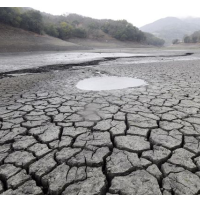Drought “Very Likely” Due to Climate Change; 14 Towns Soon to Run Out of Water
 Almaden Reservoir near San Jose (photo: Marcio Jose Sanchez, Associated Press)
Almaden Reservoir near San Jose (photo: Marcio Jose Sanchez, Associated Press)
The drought that has afflicted California and the West over the past several years is probably linked to global warming, according to a new study, and among the drought’s victims are 14 communities in the Golden State that could run out of water by the end of the year.
Scientists at Stanford University say the multi-year drought has been caused by a prolonged region of high pressure over the Pacific Ocean that has diverted storms away from the state. The so-called “Ridiculously Resilient Ridge” pushed the jet stream far to the north, keeping storms from hitting California, Oregon and Washington. The water that should have fallen on the West Coast went instead to Alaska and the Arctic Circle.
Noah Diffenbaugh, an associate professor of environmental Earth system science at Stanford and a senior fellow at the Stanford Woods Institute for the Environment, and his colleagues reported that the persistent high pressure could be the result of man-made greenhouse gas concentrations in the atmosphere.
“Our research finds that extreme atmospheric high pressure in this region—which is strongly linked to unusually low precipitation in California—is much more likely to occur today than prior to the human emission of greenhouse gases that began during the Industrial Revolution in the 1800s,” Diffenbaugh said.
The Stanford research was part of a collection of more than 20 climate reports published last week in the Bulletin of the American Meteorological Society.
The drought has already cost the state’s agricultural sector more than $2 billion and eliminated 17,000 seasonal and part-time jobs. All 58 of California’s counties have been declared “natural disaster areas” by Governor Jerry Brown due to the shortage of precipitation.
The Association of California Water Agencies says at least 14 communities—those that rely on single sources such as a stream or well for water—could run dry within the next 60 days unless steps are taken to ship water in.
The association’s executive director, Tim Quinn, told the Los Angeles Times that the list could grow and include larger cities. “If this drought keeps on going, some larger, more sophisticated communities are going to be in trouble next year,” Quinn said.
The 14 affected communities are all in Northern California and range in size from 20 people in Mendocino County’s Lower Lake to the nearly 1,500 people in the city of Montague in Siskiyou County.
–Noel Brinkerhoff
To Learn More:
Causes of California Drought Linked to Climate Change, Stanford Scientists Say (by Ker Than, Stanford University)
California Drought Worsened by Climate Change, Scientists Say (by Joaquin Palomino, Reuters)
Drought Has 14 Communities on the Brink of Waterlessness (by Hector Becerra, Los Angeles Times)
California's Drought Linked to Greenhouse Gases, Climate Change in Stanford Study (by Lisa M. Krieger, San Jose Mercury News)
Are Humans Causing the Drought? (by Aaron Orlowski, Orange County Register)
Drought Impact on Public Drinking Water Systems (State Water Resources Control Board)
80% Chance of 10-Year Drought in Southwest; 50% for a Megadrought (by Ken Broder, AllGov California)
Study Links California Drought to Global Warming (by Ken Broder, AllGov California)
- Top Stories
- Controversies
- Where is the Money Going?
- California and the Nation
- Appointments and Resignations
- Unusual News
- Latest News
- California Forbids U.S. Immigration Agents from Pretending to be Police
- California Lawmakers Urged to Strip “Self-Dealing” Tax Board of Its Duties
- Big Oil’s Grip on California
- Santa Cruz Police See Homeland Security Betrayal in Use of Gang Roundup as Cover for Immigration Raid
- Oil Companies Face Deadline to Stop Polluting California Groundwater





